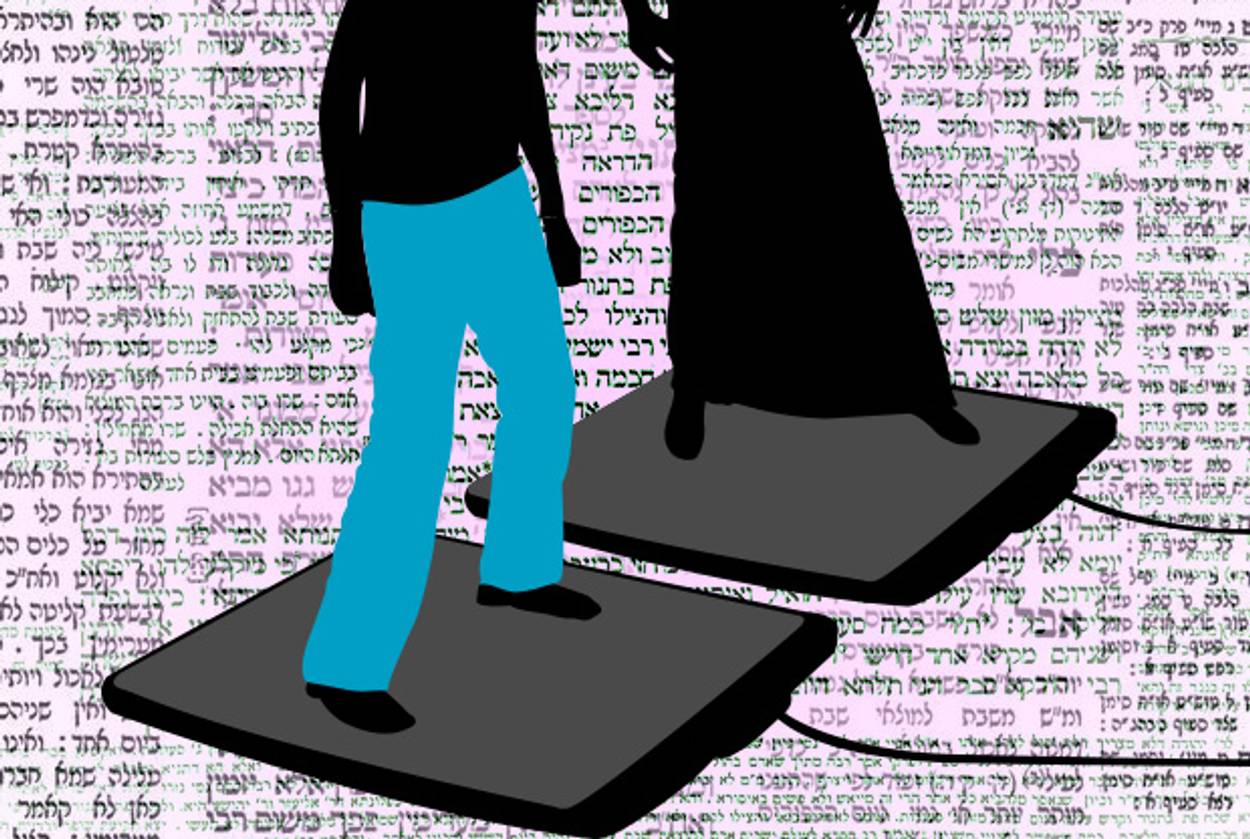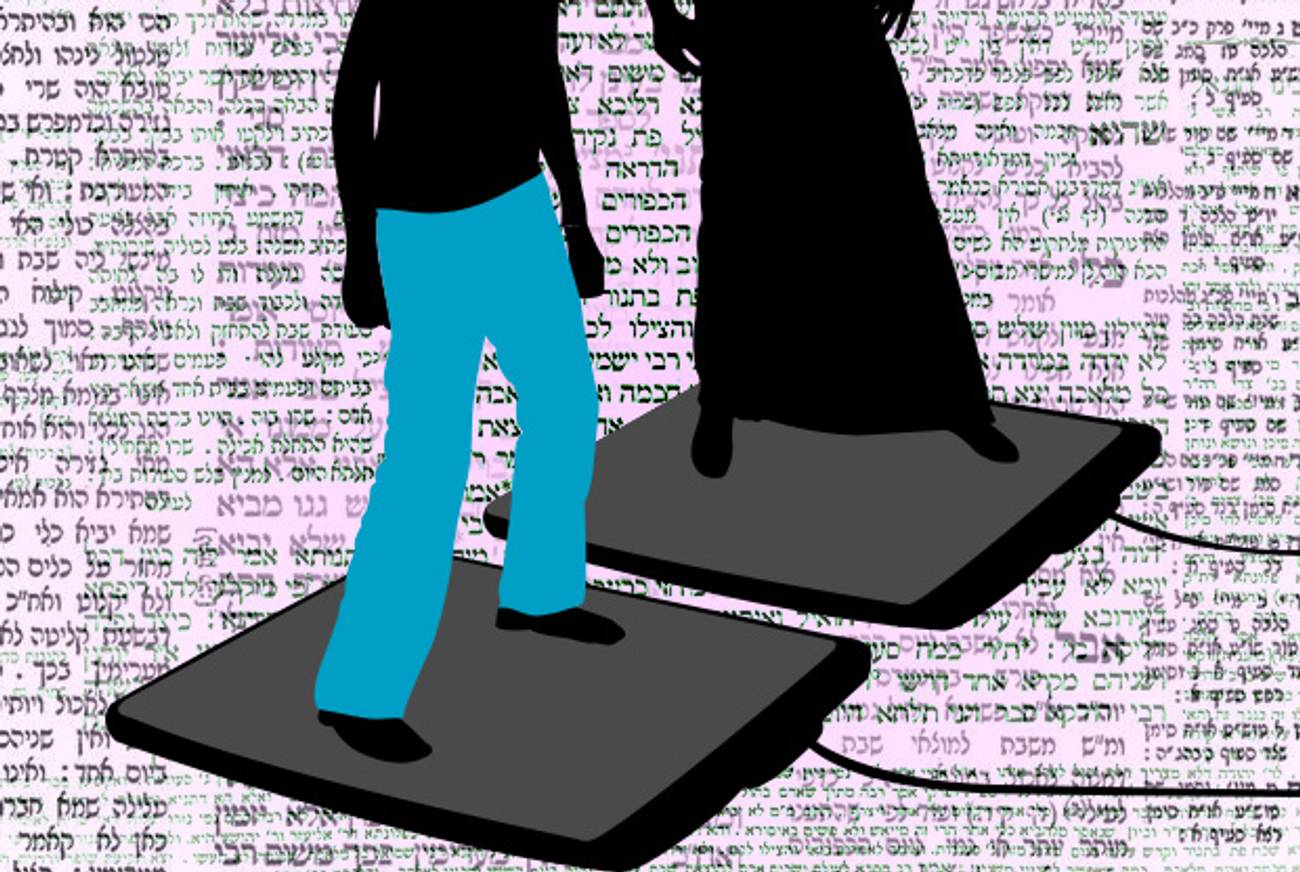Pants, Pants Revolution: How My First Pair of Jeans Redefined Modesty for Me
When I bought jeans recently, I redefined what ‘tzniut’ means to me as an Orthodox woman




When I bought a pair of jeans earlier this year, I felt like I was driving home with a terrible cargo of guilt and sins. They were the first jeans I’ve ever purchased.
As a proper Orthodox girl, I’ve worn skirts for as long as I can remember. Not only were skirts simply what my community, not to mention my parents, deemed appropriate dress for women. To me, pants represented Sinful Temptation. Sure, it’s an extreme association to have with an item of clothing, but the Judaism with which I was raised excelled at playing the guilt card, and I’ve been an eager card-carrying member my whole life. So, dutifully and without question—although rarely happily—I wore skirts.
But now I’ve joined the “Pants, Pants Revolution,” the name a friend of mine has given to the growing number of Orthodox girls deciding to wear pants—which among my peer group is becoming a more common phenomenon. And once I joined the revolution, I couldn’t stop. I went back out almost immediately and bought several more pairs.
When I was growing up as a Modern Orthodox kid, I would cast my eyes longingly at pants. My friends in grade school, who were also Modern Orthodox, wore them. Like any child, I didn’t enjoy being different, but I believed that wearing pants was simply “wrong” and skirts were “right.” I thought I was following halakhah better than they were. When I went to a high school and then a seminary where only skirts were allowed, the issue faded for several years. By the time I finished school and found myself once again in a circle of friends in which wearing pants was common, I didn’t give it much thought. I was no longer uncomfortable being different. In fact, I embraced it. After more than 20 years, wearing skirts didn’t even occur to me as something I could or should change.
But then my younger sister, 21 and living the Modern Orthodox life in Israel with her husband, called me one day a few months ago and informed me that she had done some halachic research and decided that wearing pants poses no problem for women today; she sent me her readings and the rabbinic teshuvot that supported her decision to start wearing pants, and I realized I agreed. I’d been taught that one of the main reasons pants aren’t allowed is because they’re begged ish—men’s clothing, which is forbidden—but had never understood why they’re still considered men’s clothing in today’s age. It turns out, there are rabbis who agree with me. It felt silly, suddenly, to spend my life dictated by social expectations that, to me, didn’t have legal backing. Especially if that expectation was uncomfortable, hard to walk in, and made sitting Indian-style incredibly awkward.
But still, I hesitated. By this point in my life, I thought about all my actions as personal decisions instead of mindless movements dictated by a higher, intractable law; I wanted my life decisions, and my religion, to grow out of mature choices and meaningful thought. Yet wearing skirts wasn’t just about obeying a higher, intractable law that I wasn’t sure I believed anymore. To me and my community, skirts are a symbol of something more than a fashion decision; they are symbols of Orthodoxy, the mark of belief in a religion that can and will guide the minutest aspects of our day. There was something nice about being recognizable as belonging to Orthodox Judaism. When I would spot a man with a kippa or a woman in a skirt and long sleeves, there was an implicit understanding, an invisible head nod of recognition that only we could perceive. This social aspect, more than anything, made me appreciate the strict bindings of modesty laws, especially as my social circles grew and I began working outside the strictly Orthodox community.
I wondered: Why fix something that’s not broken? Even if I was swayed by my sister’s reasoning and didn’t see a halachic problem with wearing pants, I was used to wearing skirts. I was OK with it. But as weeks passed and became months, I would find myself staring longingly as women passed easily in pantsuits, looking so professional and comfortable that my pencil skirt seemed more like a shackle than an item of clothing. It happened on a level I didn’t even recognize, so much so that I was caught off guard the moment my mind was made up: I would start wearing pants. Such a monumental decision didn’t seem like the type of thing that would happen while walking to the bathroom at work one day. But it did. Just like that. Well, “just like that” after months of consideration.
I wanted pants, I decided, which meant I needed to buy some. This fateful shopping trip was the culmination of weeks, or even years, of a mind slowly reaching its own decision. And yet I didn’t even know I would be buying pants that day until I was standing at the register of Fox’s holding a pair of jeans, among all the new clothing I had set out to buy for the upcoming holidays. From the dressing room where I’d tried them on to the register where I laid them down, I went back and forth in my mind: I’ll buy them. No, I’ll put them back. I’m brave enough for this. Actually, I’m not.
But I had gone shopping that day with my sister, and she encouraged me to try the jeans on. I tried on pair after pair, discarding all of them in indecision, until I was left with one pair that I couldn’t seem to get rid of. Snug but soft, comfortable but flattering, they were the type of faded jeans that seemed like a staple for every other woman’s wardrobe—and now, apparently, mine. So, I threw them on the pile and paid for them. They were mine, and I was a step closer to actually wearing pants in public. It felt thrilling and normal all at the same time. I looked good. I felt good. And I was buying jeans. I felt so … normal.
Jeans, beyond pants, are the essence of comfort, the symbol of the average American. Male or female—it doesn’t matter. If you’re American, you probably have jeans. You wear them to your family football cookouts, or whatever typical Americans do in their free time. When I wore them, I knew I wouldn’t stand out as different from everyone else, as I had for most of my life. I would be like any American girl, wearing her jeans.
When I got home, I suddenly felt nervous all over again, like a teenager afraid to come home smelling of alcohol. I hesitated, then told my mom, “I bought pants.” She turned to my sister and joked, “You corrupted her!” And that was it. Nothing more was said. Once again, I was reminded that I’m 23 and can make my own decisions, something that takes longer to sink in than it should. That step over with, I proudly showed them off to my fiancé, whose only real question was why it had taken me so long to come to the decision he knew I’d wanted for so long. And then, in a flurry of excitement and the reality hitting me, I texted some friends.
“I’ve officially joined the Pants, Pants Revolution!” I said. They all demanded pictures. No one was shocked; I was the girl who publicized sex at Stern, after all. It was only natural that I should wear pants. It was only bizarre that it had taken me so long to realize that, as much as I grew up being the quintessential Modern Orthodox good girl, I didn’t belong in the group of girls who did as they were told because they were told it was right. I think for myself. And now I wore those decisions publicly.
The truth is, I expected more shock from more people, which I haven’t gotten. My boss didn’t even notice I was dressed differently until I asked him when he was going to notice it. My friends didn’t blink. My fiancé’s parents, who didn’t say anything for days after they saw me in jeans, finally asked me about them—but were simply curious how I had gone from wearing no pants to suddenly owning four pairs. “I just bought them all now,” I explained. A couple days after buying that first fateful pair, I realized I wanted more. So, I bought two pairs of pants and another pair of jeans. And that was it. I may have felt different, more myself in some ways and more new in others, but to everyone else I was the same.
When I first started wearing jeans, I checked myself in the mirror a hundred times a day. Did they accentuate my thighs? Make me look even shorter than I already am? But now, months later, I’m actually more comfortable with my body in pants than I ever was in skirts. I actually feel more modest than before. Instead of battling a subconscious desire to rebel against the modesty laws I felt were imposed on me without my being asked, I now feel as if I have chosen my own path of tzniut, and the items of clothing like shorter skirts and low-cut shirts that I used to wear despite the fact that they were risqué (or maybe because they were risqué) no longer feel necessary. If anything, I feel more honest about who I am in pants—not to mention more comfortable.
And just because I’ve changed my attitude toward pants doesn’t mean that I’ve given up on tzniut altogether. Quite the contrary—I’ve defined what modesty means for me and embraced it. Now that I’m married, I cover my hair every day. The hats, perhaps seen simply as a hipster style by most people, are recognizable to other Orthodox Jews as a symbol of my marriage—they are, in some ways, the new skirt. This makes my decision to wear pants even more comfortable with me: I have chosen my own path in the complex laws of modesty, and in doing so I have found a precious balance of being me and still being recognized as a fellow Jew.
Simi Lampert is the founder and former Editor-in-Chief of the Beacon, as well as a writer for New Voices Magazine.